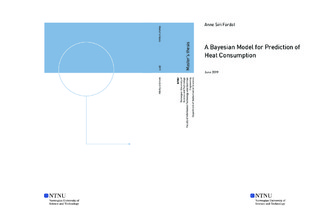A Bayesian Model for Prediction of Heat Consumption
Master thesis
Permanent lenke
http://hdl.handle.net/11250/2624612Utgivelsesdato
2019Metadata
Vis full innførselSamlinger
Sammendrag
Når man planlegger utbygging av nye områder, er det viktig med korrekte prognoser for varmeforbruk for å kunne sikre et passende kraftnett. I denne oppgaven presenterer vi latente gaussiske modeller, implementert i R-INLA, for langsiktig prediksjon av varmeforbruk per time per kvadratmeter. Modellene inkluderer blant annet ulike værforhold, og effekter for sykluser, både daglige, ukentlige og årlige. Vi anvender en additiv regresjonsmodell, satt opp som en latent gaussisk modell, for å støtte ikke-lineære effekter. Ulike kombinasjoner av kovariater og hvordan de blir modellert er testet på grupper av kontorbygg i Oslo og Trondheim. Resultatene viste at de to områdene krevde ulike modeller. Modellen for Oslo som ga best resultat var den som inkluderte syklusene nevnt ovenfor, i tillegg til værforholdene temperatur og vindhastighet. I Trondheim var det en lignende modell som i Oslo som ga best resultat, men effekten av vind er utelatt, og en langsiktig lineær trend er inkludert. Begge modellene fanget opp de underliggende prosessene som forårsaker observasjonene, men vi hadde korrelasjon i residualene som betyr at videre arbeid med modellene er nødvendig. Accurate prediction of heat consumption is important when developing new neighborhoods to ensure a suitable power grid. In this work, we present latent Gaussian models, estimated in R-INLA, for long-term prediction of hourly heat consumption per square meter. They include, among other things, weather conditions and terms for seasonality, both daily, weekly and annually. An additive regression model is utilized, set up as a latent Gaussian model, to support non-linear terms. Different combinations of covariates and how they are modeled are tested on collections of office buildings in Oslo and Trondheim. It was found that there was little difference in predictive power between the models explored. The two areas require different models, where the model for Oslo that was most successful was the one containing the cycles mentioned above, in addition to the weather conditions temperature and wind speed. For Trondheim, a model similar to the one in Oslo, but where the effect of wind speed is omitted, and a long-term linear trend is included, offered the greatest fit. Both models were able to catch the underlying process well, but correlation in the residuals signifies that more work needs to be done.
